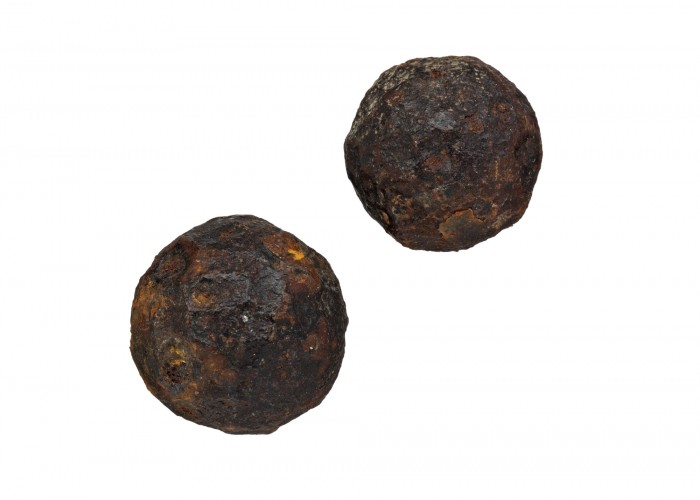Canister Shot from Waterloo
These are balls from a canister shot, a kind of short-range cannon ammunition fired at the Battle of Waterloo. Canister shot – named because these iron balls were packed inside a tin canister for firing – was designed to as a weapon of last resort, used by desperate cannon crew to fire on enemies as they charged at the guns. Like a giant shotgun shell, the canister would explode and fire out these iron balls in a devastating blast.
These canister shot balls were dug up from the battlefield in the aftermath of Waterloo. Complete canister shots are very rare, because they were destroyed by being fired.
Most of the cannon shots fired at Waterloo were round balls, which could travel more than 1000 metres and smash through formations of men. However, if the enemy got too close to the guns, canister shot was used.
The canister was a thin tin cylinder, packed with iron balls and sawdust. This was fitted with an explosive gunpowder charge at the bottom and an iron lid. When fired from a cannon, the canister would disintegrate and the balls spread out into a lethal cone, about 30 metres wide with a range of 300 metres. This storm of iron balls could scythe through men and horses, killing dozens with every shot. At the Battle of Waterloo, the ground in front of the British cannons on the ridge of Mont St. Jean was piled with dying horses after disastrous French cavalry charges.
One other kind of cannon shot was an exploding shell, a hollow iron case filled with gunpowder. These were fitted with slow-burning fuses, designed to explode just before they reached the target and shower down splinters of burning iron.
These might be balls from a special “shrapnel” shot, a weapon unique to the British at Waterloo. This was a combination of the exploding shell and the canister shot, a hollow iron sphere filled with gunpowder and musket balls, ignited by a fuse. Correctly used, this shot could explode in the air and blast the enemy with balls, like a long-range canister shot.
This was a sort of British “secret weapon”, invented by Henry Shrapnel in 1784 – his name has become synonymous with the debris from artillery shots.
-
Curatorial info
- Originating Museum: National Army Museum
- Accession Number: NAM. 1999-05-10
- Production Date: c. 1815
- Material: Iron
-
Use this image
- Rights Holder: Copyright National Army Museum.
- License Type: All Rights Reserved
Find it here
This object is in the collection of National Army Museum







